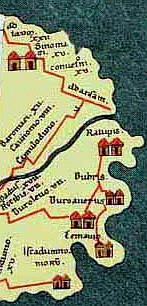The sources for early Britain are archaeological, linguistic and historical. For the early names applied to Britain the linguistic and historical sources must be drawn upon.
Linguistic material from the prehistoric period may be preserved in the names of places and of natural features. This evidence is notoriously difficult to validate and interpret due to the scarcity of early written forms. Fragmentary linguistic material is preserved from the very end of the prehistoric period in coin legends.
In the fourth century BCE the Greeks colonising the western Mediterranean were vaguely aware of Britain.
Close to 320 B.C.E., Pytheas, one of their navigators from Massalia (Marseilles), sailed in the Atlantic to the British isles, visited the tin mines of Cornwall and may have continued as far as southern Norway and along the south coast of the Baltic to the Vistula mouth. His report is lost but glimpses of what it may have contained are given by later writers.
Eratosthenes in the third century B.C.E. schematised the island of Britain as an elongated triangle with capes named Belerion, Orkas and Cantion.
The historic period may be said to begin with the reports of J Caesar in his De Bello Gallica. Caesar, writing in the second half of the first century B.C.E., mentions Cantium (Kent), Mona (Man or Anglesey), and Hibernia (Ireland). Linguistic evidence is now generally more abundant in the form of place, personal, tribal and natural feature names.
In the mid-second century CE an Alexandrian scholar, C. Ptolemaeus, produced his Geography using earlier materials including lost work of Marinus of Tyre.
The Antonine Itinerary, probably third century C.E. but using some older information, lists stopping places on roads throughout the Empire. It gives mileage between posts and total distances.
 The Peutinger Table, a pictorial road atlas, is also probably third-century. Although related to the Antonine Itinerary it is not derived from it. The surviving copy is of Carolingian date. Most of the map of Britain is lost.
The Peutinger Table, a pictorial road atlas, is also probably third-century. Although related to the Antonine Itinerary it is not derived from it. The surviving copy is of Carolingian date. Most of the map of Britain is lost.
 The Notitia Dignitatumtam ciuilis quam militarisan is an early fifth-century list of civil and military offices and their locations in both halves of the Empire.
The Notitia Dignitatumtam ciuilis quam militarisan is an early fifth-century list of civil and military offices and their locations in both halves of the Empire.
The Ravenna Cosmography was compiled by an anonymous cleric of Ravenna c 700 C.E. using much earlier materials. Although corrupt and difficult to interpret it contains more information about Britain than any other source.
The quasi absence of any texts in British condemns us to seeing these names through Latin or Greek filters. Historical sources add little to the understanding of the names - descriptive texts are rare and usually superficial.
The material is poor when compared with contemporary Gaul. Not a single document in British can be shown to have been written in the British Isles throughout the Roman period.
In the immediate post Roman period (fourth century) new information appears in the form of brief inscriptions in Irish, mainly found in Wales. Old English texts written in the British Isles appear in the ninth century and they are joined by texts in Welsh and Irish. There is no doubt that some of these texts were inspired by and influenced by older written and oral sources that we no longer possess.